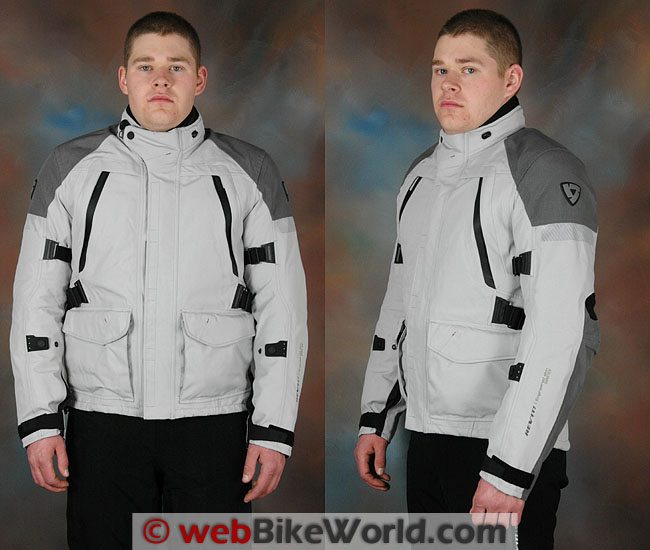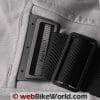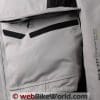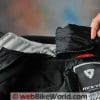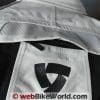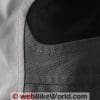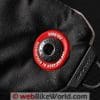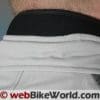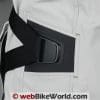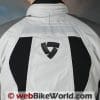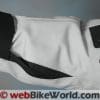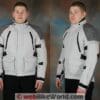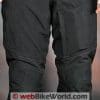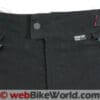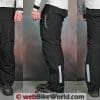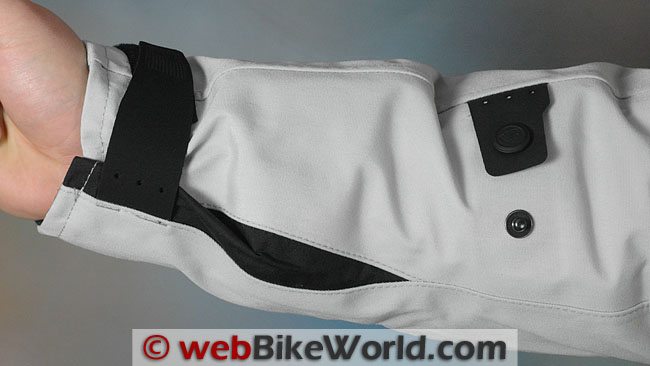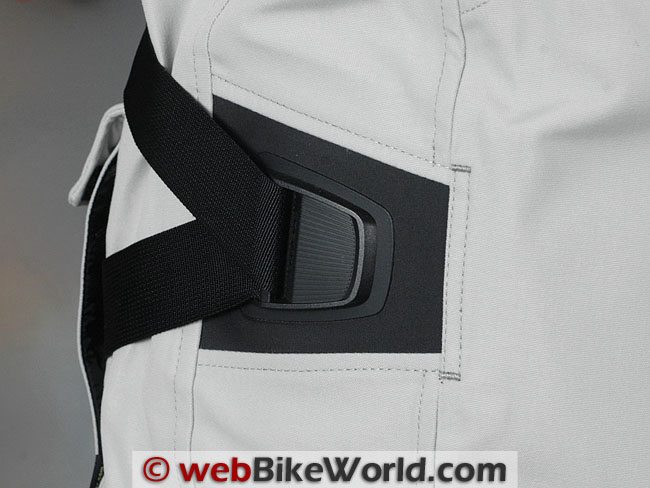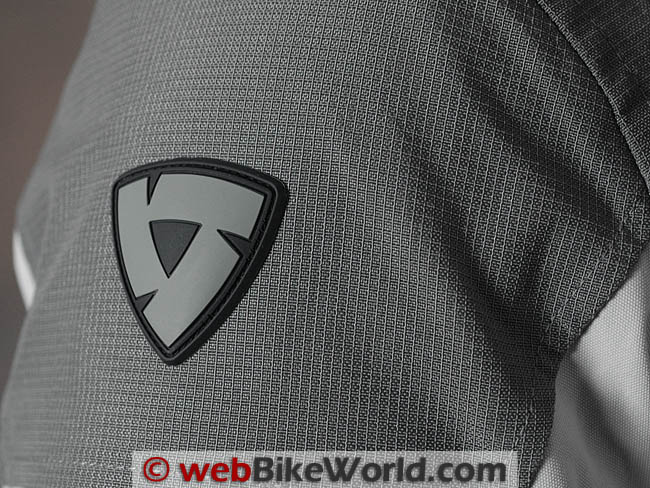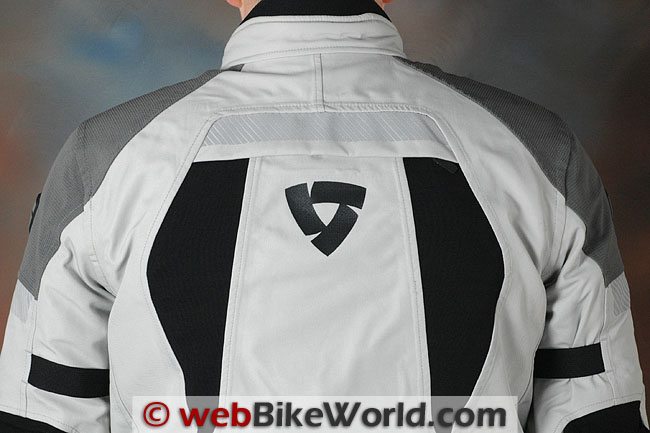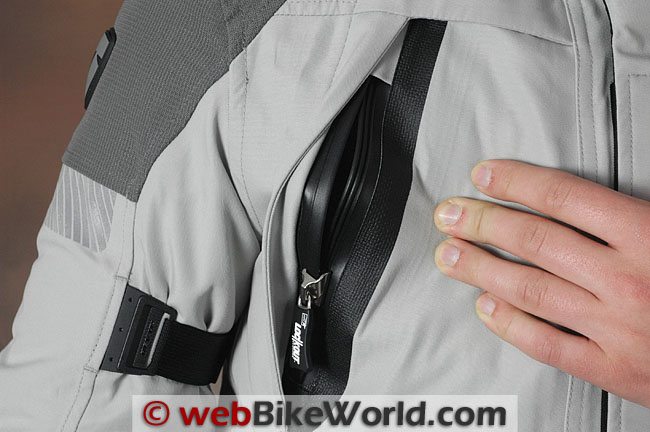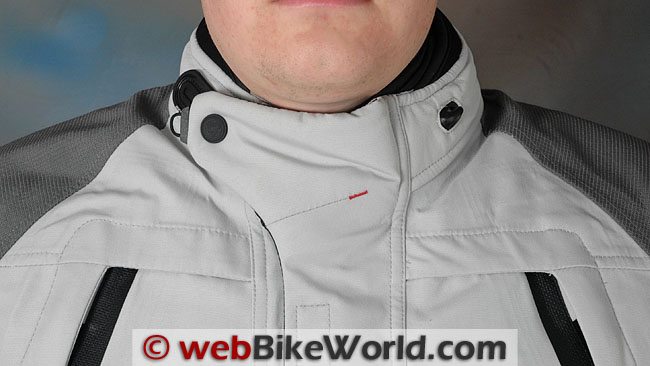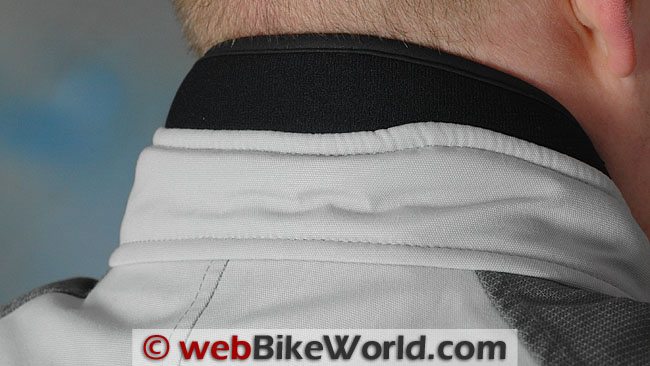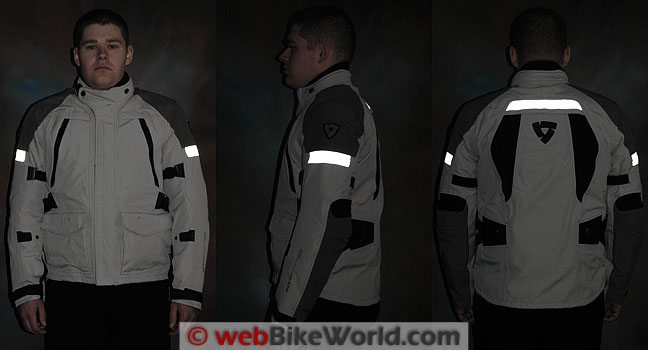The new Rev’it Everest GTX jacket is the company’s top-of-the-line product for 2011. It uses the most recent Gore-Tex technology, materials and features, including the Lockout closure system. It is impeccably tailored and constructed. It is biased more towards the street/sport and touring rider than the Defender GTX, which is an adventure-touring design.
I first described the new Rev’it Everest GTX jacket in this preview of the Rev’it 2011 clothing lineup in August of 2010. The jacket was also previewed in this more detailed report, along with a video tour of the Everest GTX jacket and Gore “Lockout” zipper. Rev’it has now released the entire 2011 lineup, with the new Everest GTX jacket and pants occupying the current top spot in the technology employed.
The “GTX” designation indicates that Gore-Tex products are used in the clothing. I reported back in January of last year in an article on the Rev’it and Gore-Tex partnership, and Gore-Tex has been working with Rev’it on product development since then, and the results are very evident in the Everest GTX outfit.
Rev’it has released many other new products for 2011 and we hope to review more of them soon. In the meantime, this review will describe the Rev’it Everest GTX jacket and pants, with some comparisons to the Defender GTX jacket (review).
The Everest GTX jacket and pants currently occupy the top spot in the Rev’it Gore-Tex (“GTX”) lineup for 2011. The Everest GTX clothing uses the latest Gore technology; for example, the jacket and pants shells are made from the premier Gore-Tex Pro Shell 3-Layer with Armacor.
These materials were described in detail in our report on the differences between Gore-Tex fabrics, which also has close-up photos of the membranes. The Gore-Tex Pro Shell Armacor 3-Layer Cool product that is used for the majority of the Everest GTX outfit has two major differences that are discernable to motorcyclists. First, the shell material has a smoother, less textured and slightly “harder” surface finish than the slightly more open weave in the material used on the Defender GTX jacket.
The fabric on the Everest GTX jacket is also different from the normal types of Cordura found on many lesser motorcycle jackets in the way it feels and looks. Some types of Cordura seem to be what I can only call “less refined”, with a more open weave that is visible as a sort of micro-mesh.
The Gore-Tex Pro Shell is waterproof at the outside; in other words, the Everest GTX jacket is completely waterproof at the outer boundaries of the shell itself and the jacket does not have, nor does it need, a detachable waterproof (or windproof) liner.
As we mentioned in the Gore-Tex fabric comparison report, this is the “Holy Grail” of many motorcyclists — a jacket that repels water at the outer layer and does not get soaked and does not require a special liner to maintain waterproof integrity.
A benefit of having a waterproof outer shell means that the outfit is noticeably lighter in weight than other all-weather jackets and pants, because no waterproof liner is needed. Our size large Everest GTX jacket, with the Exkin Air insulating liner, weighs 2364 grams (4-3/4 pounds). The size large pants weigh only 1617 grams (3-1/4 lbs.), about as much as a lightweight helmet.
This is not only a noticeable difference, it also makes the fit feel more tailored. For example, remove the very lightweight (exactly 400 grams) Exkin Air insulating jacket liner and there’s very little difference in the sizing. This compares to other jackets and pants that can gain as much as 1.5 sizes when the liners are removed, making size choices difficult without ending up with clothes that are too loose and baggy for summer riding.
Other features of the Everest GTX outfit include the use of the latest version of the Gore-Tex Lockout waterproof “zipper” (closure is probably a more correct term), which we first described in this 2009 report. The outer shell material also has the Gore-Tec “Cool” designation, which means it is specially treated to help prevent solar heating, even in the black color.
SAS-Tech armor is included in this top-of-the-line outfit, along with storm cuffs in the sleeves, a storm collar, removable collar on the Exkin Air liner and highly reflective laminated striping.
The Waterproof Issue
So let’s address this topic right from the start. Does the Gore-Tex Pro Shell work as advertised? Yes. Is it perfect? Well, let’s just say there are some tradeoffs.
Personally, I think the obsession with having a motorcycle jacket shell completely waterproof is rather silly. The Defender GTX jacket (and others) work very well indeed in all weather conditions and, in fact, the ability to remove the waterproof/windproof liner can actually be a benefit in hot weather, where you don’t necessarily need or want a barrier between you and the cooling air flow.
Nevertheless, many motorcycle riders want a truly waterproof jacket and pants, without having to bother about removing and installing a liner to achieve it.
I can definitely understand where this would be a great benefit in regions like the Northwest United States, with highly changeable and (mostly) rainy weather conditions. In fact, it wouldn’t take much at all to convince me that the Everest GTX outfit was designed specifically for motorcyclists in Seattle!
In somewhat of an irony, we have been experiencing the perfect weather conditions to evaluate the Everest GTX jacket over the last several weeks. During this time of year (Spring), conditions can change daily, from near freezing in the morning to pouring rain (and we’ve had lots of it!) to mid-70’s by afternoon.
Burn, Bill and I have been taking turns swapping out the Everest GTX outfit, deliberately going for rides in the torrential rainstorms. So let’s get the waterproof topic out of the way, because I know that’s of primary interest to many webBikeWorlders.
The Everest GTX jacket is indeed waterproof. When water hits the outer shell, it almost appears to be some sort of magic trick. The water does not stick; it beads up and runs off as if there were some kind of Anti-Grav Neutronic Repel-O-Matic charge on the fabric. I can literally hold the fabric under a raging water faucet for minutes at a time and the water simply beads up and rolls off faster than it does on a Teflon-coated frying pan.
So for all practical purposes, the Gore-Tex shell fabric absorbs zero H2O and the Everest GTX shell is as waterproof as any pure rain clothes I have ever owned. I have tried pouring water from the faucet and bathtub on the jacket and literally by time I walk into the other room, the fabric is dry (it doesn’t seem to get wet to begin with) and you’d never know that it had just experienced a deluge.
This was proven and duplicated in several rain storm riding sessions we have experienced locally over the last few weeks.
Key Features of the Rev’it Everest GTX Jacket
I’m going to proceed a bit differently with this review and discuss the features in general, rather than in a detailed listing.
Touring or Adventure?
First, let’s discuss the fit. The Everest GTX jacket is listed in the Rev’it “Touring” section on their website. The Rev’it website can a bit confusing — selecting “Touring” and “Gore-Tex” on the home page doesn’t seem to lead anywhere, so skip that and select the “Products” button instead, way down in the right-hand corner.
Once there, select the “Men”, “Touring” and “Jackets” check boxes…then select the “Gore-Tex” tab. Whew! We made it.
There are two jackets listed when selecting this combination of categories: the Legacy GTX and the Everest GTX. Curiously, both jackets are cross-listed in the “Textile” section also. The Defender GTX (review), the Cayenne Pro (review) and the Rev’it Sand jacket (review) can be found under the “Adventure” category.
The reason I’m taking you on this categorization tour is to illustrate that the Everest GTX jacket is apparently considered a Touring garment by Rev’it; the Everest GTX jacket and pants are listed in the Rev’it catalog as having a “Tour Regular” fit.
This was a surprise to me — I was under the impression that the Everest GTX outfit would be a sort of “Defender GTX to the Max” — something like a “Professional Use Only” adventure-touring outfit. Instead, the Everest is styled and cut much more like a jacket and pants you’d wear for street/sport/touring or full touring.
This is not a negative by any means; just a surprise, because sport/touring seems to be a forgotten category by most manufacturers recently and to think that Rev’it put their ultimate tech into a touring outfit is pretty interesting.
Not that the outfit can’t be used for adventure-touring — and this, of course, is the problem with trying to put anything (including people) into a specific category.
Jacket Fit
The Everest outfit does have a different feature set than the Defender outfit and it also has a different fit. First of all, the size large Everest GTX jacket and pants fit our model like a bespoke London suit. Honestly, it could not have been a more perfect match — and it looked absolutely mahvelous.
The fit is snug, as it should be, but the size large fits exactly as it should. It’s street/sport/touring snug, with a fit that is closer to a street (non-motorcycle) jacket and pants than for off-roading or adventure-touring.
This means that the cut, styling and tailoring give the Everest GTX outfit more in common with a two-piece sport/street/track rider’s suit than a bulky adventure-touring outfit that would be worn over several layers and a pair ofVendramini Elefant boots (review).
But the styling and tailoring also make for a very comfortable outfit. Something to note is that the slightly “harder” or “stiffer” surface finish and feel of the Gore-Tex Pro Shell material provides a different feel to the wearer than the Defender GTX.
Fit and Styling Performance on the Road
The outfit also has a lighter feel when you’re on the bike, due to the absence of the (unnecessary) waterproof liner. The lighter weight is definitely noticeable, offering a more liberating environment when riding.
With the outstanding Exkin Air insulation, all you need in cool weather is a light under-layer from a good pair of dedicated motorcycle underwear (reviews), such as the Sub Zero (review) stretchy undies or the Spark thermals (review). In fact, wearing these types of ultra-quality stretchy thermals under the Everest GTX outfit is a liberating experience to anyone who has been wearing the simple lower-tech motorcycle garb of the proletariat.
The jacket even has a sleeker profile and look than the Defender GTX or Cayenne Pro; it’s bereft of the exterior accoutrements of the Defender GTX, Sand jacket or Cayenne Pro, which add to its sport/touring style.
The typical adventure-touring focused jacket has more pockets, zippers, vents and other Swiss Army knife chaff hanging on it — including things like hooks for hydration bladder hoses and the hydration pack itself. It’s the Carhartt overalls to the Everest’s three-piece suit.
Pockets and Adjusters
More examples of a trimmer design philosphy can be found in the arrangement of the pockets and the clever layout of the arm and waist adjusters.
The Everest GTX jacket has two front pockets (waterproof) with open hand warmer slots behind. The only other pockets are inside the jacket, one on each side, covered with a horizontal zipper. The jacket does not have the vertical wallet pocket in the placket that is featured on most of the other Rev’it jackets.
The arms have a single snap adjuster on the forearm, along with a new (for Rev’it) type of upper arm adjuster that cleverly hides the adjustment slider under the arm, which keeps the profile of the jacket looking very sleek indeed.
The rear adjusters are also semi-hidden (from the front view anyway), with large “V” shaped elastic straps joining an anchoring lever bar over the kidneys on either side. The lower front strap is another clever design; it terminates inside the hand warmer pocket, effectively hiding the strap from view.
The jacket also has a hidden adjuster at the hem, on the inside of the shell. This can be tightened to block air from coming in underneath. There are dual attachment zippers inside the jacket, full length and a shorter zipper which connect to the Everest GTX pants or other matching Rev’it pants. The full-length zipper is another clue that the Everest jacket has more sporting pretensions than the Defender, Cayenne Pro or Sand jackets.
Ripstop Cordura and Stretch Materials
The rip-stop material used in the Defender GTX jacket is also used to good effect in the Everest GTX, with contrasting gray on the shoulders and along the back of the arms in this gray version of the jacket. Black on black is also available.
The back of the elbows and the “wings” in the back of the jacket (black vertical bars in the photos) are a type of Gore-Tex elastic material, which gives the jacket some stretch with style.
Everest GTX Ventilation and Gore-Tex
This is a separate section because I think this topic is the most significant differentiator between the Everest GTX and the rest of the current Rev’it jacket lineup; i.e., the Defender GTX, Cayenne Pro, Sand and others.
Gore Lockout Closure
The Everest GTX is definitely waterproof; we have established that, as described at the beginning of this review. One of the features that ensures that water integrity is the use of the new Gore “Lockout” zipper…sorry, I mean “closure”.
I first described this technology in this 2009 report, which includes a video animation of the zipper. The first production version of the Lockout zipper was previewed in this Everest GTX jacket “First Look” during my August 2010 visit to Rev’it USA headquarters.
My guess is that some of the delay in getting the Everest GTX to market was due to a revision by Gore of the Lockout zipper design. This most recent version, used in the current Everest GTX jacket, seems different — in a good way.
I don’t have an original to compare it to, but looking at the photos of the first version of the Lockout zipper indicates that the current production version is wider, slightly thicker, with a different channel design that replace the traditional zipper “teeth”.
The new design, as implemented in the Everest GTX, also places the Lockout closure on a wide section of rubberized backing, which is then bonded to the jacket shell. Indeed, this may have been the design change that slightly delayed the final production version.
The Lockout closure is positively waterproof, and in a way that no other zipper can be. The newer version also has a larger pull, which provides more leverage to slide the runner up and down. The Lockout closure requires slightly more effort to open and close than some — but not all — traditional zippers.
The vents and other openings in any motorcycle jacket are usually the weak points in terms of water integrity. This is another reason why a removable waterproof liner is usually the most efficient, effective and least expensive way to go to keep the rider dry.
Ventilation
Vent openings are especially difficult to design correctly, because even the stitching can cause a leak if it pokes through the bonded liner.
Jackets that claim to have a waterproof outer shell can also prevent the transfer of heat and moisture from the rider’s body. Basically, in the past, you could have water resistance or you could have ventilation, but you couldn’t have both.
The use of the Gore-Tex membrane in higher-end motorcycle jackets has changed that, for the most part. The Gore-Tex Pro Shell used in the Everest GTX is waterproof at the outer boundary, and the Lockout zipper design maintains that integrity.
The two Lockout closures used for the front vents on the Everest GTX jacket work well and, contrary to initial reports by some, do not open unexpectedly. They can be bent, twisted and abused, but you have to really, really work at it to pop one open without using the slider. And if you do, all it needs is a quick up/down with the slider and it’s self-sealed. My feeling is that it’s probably easier to pull apart a traditional zipper than the Lockout system.
The jacket includes a horizontal vent across the back, just under the flap that holds the reflective material. The traditional zipper, while not as wide as the rear vent zipper on the Aerostich Darien (review), is effective when used with the open front vents. Air can be felt flowing through the jacket, at least when riding a motorcycle without a fairing that might block the air flow.
But the overall ventilation system provided by the Lockout system isn’t quite as effective as we’d hoped. In cooler weather, there’s no problem. But there seems to be a tipping point around 75 degrees F, where the absence of arm vents and the Gore-Tex shell conspire to keep in more moisture than a jacket like the Defender GTX, which has the removable Gore-Tex membrane liner, allowing more air to seep in through the jacket shell and directly through the vents.
The arms also have an internal barrier near the cuff with elastic, presumably to maintain waterproof integrity by not allowing any water to flow in. These also block any air that might help ventilate the arms.
The Lockout closure vent is no different from a traditional zipper vent in another regard — it doesn’t stay open any easier or wider. So the vertical vents on the front of the Everest GTX jacket don’t provide as much ventilation as they could. The potential is there, because Rev’it designed not just a small slit in back of the vent, but about a 60 mm wide mesh opening. If the Lockout closure and the vent could somehow be pulled open farther, more air would enter the jacket.
Thus, so far I’m going to have to call the Everest GTX jacket a three-season design. We’ll have to wait until the really warm weather arrives to learn more, but I don’t think it will have the ventilation needed for the hottest weather, unlike the Defender GTX (which admittedly hasn’t been worn yet in hot weather also).
And in somewhat of an irony (for a Touring jacket), riding behind a big fairing on a touring bike like Burn’s old BMW K1100LT means that there is no air flowing over the jacket, which reduces ventilation even further.
Collar
There’s another design feature of the Everest GTX jacket that biases the jacket more towards cool weather riding; it’s the collar, which is taller and thicker than usual. The collar feels snug, which is fine when it’s cold or rainy. The Rev’it collar adjuster could probably be made even longer or repositioned, because I barely had enough play to snap the collar to the first position without making it feel too tight.
The jacket has a removable insulating neck liner, which appears to be also made from the Exkin Air liner material. Removing the insulating part of the collar (and stowing it in the pocket at the top of the Exkin Air liner) definitely helps. But after it’s removed, the collar on the Everest GTX jacket is still tall enough to block air flow to the neck, which can make a difference in those 75+ degree temperatures.
When the insulating collar is removed, the half of the zipper teeth remain in the jacket collar, along with the zipper that connects the insulating liner. There’s another ridge left by a seam, then some neoprene, but the neoprene is topped by another piece of lining with another seam.
All of this gives the collar a rougher feel than expected, and the combination of the tall collar, which keeps in some heat and sweat, and the rough edges makes for a scratchy experience.
UPDATE: Just thinking…This problem might be solved if there was a second zip-in collar, made from a soft and thin material, that could replace the insulated collar in the jacket after it was removed.
Everest GTX Ventilation: Bottom Line
My feeling is that there’s a bit of a compromise with the Everest GTX jacket. It’s fully waterproof at the outermost boundary of the shell, but to maintain that complete water integrity has apparently meant that a certain amount of ventilation was sacrificed. The designers didn’t help matters by adding a winter-style collar, and the Lockout vents in the front could probably provide more ventilation than they do if only they opened wider.
The absence of arm vents and the barrier provided by the Gore-Tex shell makes the arms feel warm and a bit sweaty when the temperatures start to rise. The Gore-Tex membrane in this case just doesn’t seem to allow the moisture to escape; a surprise actually. And I’m not really a person that sweats that much or that often.
SAS-Tec Brand Armor
The Everest GTX, like the Defender GTX, uses the high-quality SAS-Tec GmbH brand armor (SAS – “Sicherheit aus Schaum” or Safety of Foam/Safety of Foam Systems) in the higher-end jackets and pants.
The armor is included in the shoulders and elbows. The snug fit of the jacket keeps the armor in place, but the sport/touring cut makes the armor feel a bit more noticeable than the slightly different fit of the Defender GTX jacket. The arm holes on the Everest GTX do feel just a touch tighter than an adventure-touring cut also.
Also like the Defender GTX, the Everst GTX jacket has a thinner EVA foam back pad and the pocket is designed to fit an optional SAS-Tec back protector which is optional. At this price though, it should be included.
Miscellaneous Features
Reflectivity
The Everest GTX has strips of 3M highly retro-reflective material located on the arms and back. The material is very thin and sealed on to the body of the shell without stitching, which helps improve the water resistance.
You can see in the photo above that the material really pops when hit by light.
Sleeve Cuffs
The sleeve cuffs of the Everest GTX are a simple design, with a flat hook-and-loop tab to tighten the sleeve end. A dart allows some expandability and the internal storm collar means that the cuff can be worn over or under a glove, although heavier winter gloves with a thick gauntlet may not fit underneath.
The system, which includes the shorter length mesh liner also described above, allows the sleeves to be adjusted to the rider’s preference, then the lower part of the zipper is opened to allow quick entry and exit. This avoids the necessity of re-adjusting the hook-and-loop strap each time the jacket is worn and it saves wear and tear on the hook-and-loop.
Front Zipper
The front zipper is also an unexpectedly simple design which again illustrates the touring bias of the Everest GTX jacket. Since there is no removable waterproof liner, there is no multiple flap arrangement under the zipper like there is on other Rev’it jackets.
The Everest has a simple unbranded zipper and a short flap that covers it using hook and loop.
Exkin Air Insulating Liner
I’ve mentioned it in passing in the other sections, but just to recap, the Exkin Air liner is very light and thin, yet it provides excellent warmth in the jacket and pants. The liner attaches to the jacket with a full-length zipper that travels up one side, around the neck and back down the front.
The liner attaches in the sleeves with are two snaps in each cuff, just upstream of the elastic storm cuff. The snaps are a bit difficult to access, due to the storm cuff, but overall the liner is easy to remove and insert.
| The wBW Opinionator: Rev’it Everest GTX Jacket | |
|---|---|
| Picks… | …and Pans. |
|
|
Conclusion
The Rev’it Everest GTX jacket seems biased more towards the street, sport or sport-touring rider than the adventure-touring based Defender GTX, Cayenne Pro or Sand jackets. This was unexpected and not a negative, but needs to be stated.
The jacket also seems biased more towards cooler weather and certainly for wet weather. Combined with the Everest GTX pants, it would probably make the perfect riding suit for the Northwest U.S.
We didn’t experience the depths of winter cold during our time with the Everest GTX outfit, but the Exkin Air liner seems to provide a good deal of warmth. We’re not sure if the jacket is the equal of the Defender GTX or Cayenne Pro (or the original Cayenne) in the coldest riding conditions, and if fitted correctly, there’s not a lot of extra room for layers, due to the sportier cut.
In the end, there is a compromise here. To get true a true waterproof jacket that is the equivalent of wearing a rain suit, some ventilation and warmer-weather features are missing. Potential owners will have to decide which is more important.
My honest opinion is that I think the Defender GTX is the more all-around outfit, albeit with different styling that is nearly an apples/oranges comparison.
If I knew I was going to be riding in cooler and wetter weather, I’d reach for the Everest GTX. In all other conditions, it would probably be the Defender GTX for me.
Part II: Rev’it Everest GTX Pants Review
|
wBW Review: REV’IT! Everest GTX Jacket
|
|
|---|---|
| Manufacturer: Rev’it | List Price: $979.99 |
| Colors: Black or Light Gray. | Made In: Indonesia |
| Sizes: S to 3XL. | Star Rating (1-5): |
| Review Date: April 2011 | |
|
Note: Item was provided by a retailer, distributor or manufacturer with these Terms and Conditions.
|
|
Owner Comments and Feedback
See details on submitting comments.
From “T.G.” (November 2011): “Well written look at what may be a very good jacket. I say “may” because I wonder how well this jacket holds up when your sliding down the road. Even this $979 list jacket has no real world safety ratings. Yes there may be the “saved my butt” testimonial letters but us potential buyers have no clue how this fabric holds up.
Makers need to get some real-world lab tests done!”
From “N.C.” (05/11): “I like the look of the jacket and I agree with your assertion that a removable liner rather than a permanent bonded liner is better in warmer weather as the cooling effect in temps of 65f + is welcomed when riding.
I have one pick with the jacket and that no matter how the manufacturers tell us the Gore Lockout is good, I still do not trust it.
I was speaking to a few Hein Guericke assistants and they said other customers were put off to when wanting to buy the higher priced Gore-Tex suits thus has harmed sale’s of such suits (jacket and trousers) for me I prefer conventional zips esp when on the move I think decent zips on a jacket are good to work with, with gloves on at speed and it rains I just close the vents up no problem, the Gore Lockout out closure has to be flat to ensure it closes with no side pulling where, as metal zips can help pull the fabric together to close up. No ????
Time will tell if the Lockout closure will last but I for one will buy without them. Until I hear good results of tests with them in over a period of time, but can shops wait for my money somewhere down the line or do they want it now !! if a jacket was offered in Lockout closure and non-Lockout closure I guess sales in the non-Lockout closure would pull ahead in sales (joke) lol.
Editor’s Reply: The Gore-Tex lifetime guarantee should cover any problems. Also, I’ve had too many problems with regular zippers (broken teeth, broken pull tabs, torn fabric, etc.) over the years, so I’m not unhappy at all to see a new design.
Using the Lockout closure is easier than a zipper, based on my experience with it so far, and it seems more secure and certainly more waterproof than a zipper. I, for one, definitely hope to see increased use of the Lockout closure in motorcycle clothing.
From “J.L.W.” (04/11): “I live in Albuquerque (New Mexico) where we have had one-half inch of rain (yes, you read it right) since the first of the year, yet having a waterproof jacket is important to me.
The reason is that most of our riding is in the mountains where the weather is unpredictable and you generally run into rain squalls in the afternoon. In the Colorado mountains it rains every afternoon in the summer without fail, so this isn’t just an issue for the Pacific Northwest.
The problem with rainsuits is that they’re a pain to put on so you tend to keep riding hoping the rain will let up before you get too wet. If you put on your rainsuit when it looks like it’s going to rain it never does so you can’t win. I would just rather have a waterproof jacket and pants and not worry about it.”


